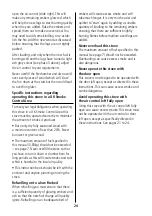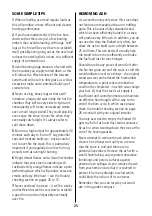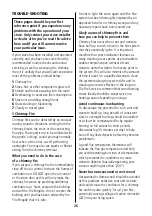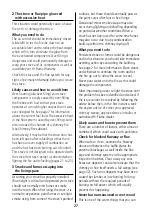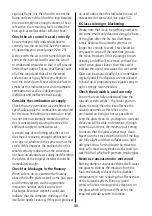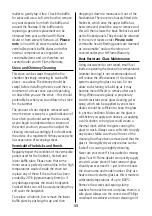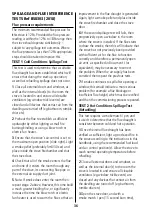
Do not re-light the stove again until the flue
system has been thoroughly inspected by an
approved installer or chimney sweep and any
necessary repairs have been carried out.
Likely causes of chimney fires and
how you can help to prevent them
Chimney fires occur when soot and creosote
have built up to such a level in the flue system
that they eventually ignite. It is important
therefore that your installation features as
many cleaning access points as practicable to
enable comprehensive removal of soot,
creosote and other debris from every point in
the system. This will also minimise the amount
of time it takes for a qualified sweep to clean
the system making the system safer and its
cleaning more cost-effective in the long run.
The Fire Service recommend that wood burning
stoves ideally should be swept twice in a
heating season depending on usage.
Avoid continuous low burning
To discourage the potential for such soot and
creosote build-up, long periods of consistent
slow or overnight burning should be avoided
or at least be compensated for by regular
burning on full output for short periods
afterwards (eg 30 minutes per day) to help
burn off any likely deposits before they become
problematic.
A good flue temperature thermostat will
indicate the flue gas temperature and help
you avoid operating your stove at a temperature
which promotes the conditions to create
creosote deposits (basically operating your
stove at anything less than 120Cº).
Never burn unseasoned or wet wood
Unseasoned or damp wood should be avoided
as this produces excessive soot and creosote
and could create the conditions for a chimney
fire and may also quickly ‘fur up’ your flue,
potentially causing spillage of carbon monoxide
(CO) into your living space.
26
TROUBLE-SHOOTING
These pages should be your first
reference point if you experience any
problems with the operation of your
stove. Only contact your stove installer
or dealer after you’ve read the advice
here and if you still cannot resolve
your particular issue.
If your stove has been installed and operated
correctly, and you have also carried out the
recommended routine checks and annual
servicing, as well as sweeping the chimney,
then it is unlikely that you will ever experience
most of the problems outlined below:
1
Chimney fire
2
Stove, flue or other components glow red
3
Smoke and fumes escaping into the room
4
Overheating or excessive fuel consumption
5
Stove not providing enough heat
6
Glass staining or blackening
7
Cloudy or crazed glass
1
Chimney Fire
Chimney fires can be detected by an unusual
roaring sound or vibrations coming from the
chimney breast, the stove or the connecting
flue pipe. The sound is not to be confused with
the gentle ‘rushing’ sound you may normally
hear when a stove has a well-performing
updraught. You may also see sparks or flames
exiting from the chimney terminal.
What you need to do in the case
of a chimney fire
If you suspect a chimney fire then immediately
close off the air control to starve the flames of
combustion air. DO NOT open the air control
or the stove door as this will only make the
chimney fire worse by providing additional
combustion air. Next, evacuate the building
and call the Fire Brigade. Do not re-enter the
building until you have been advised by the
Fire Brigade that it is safe.













